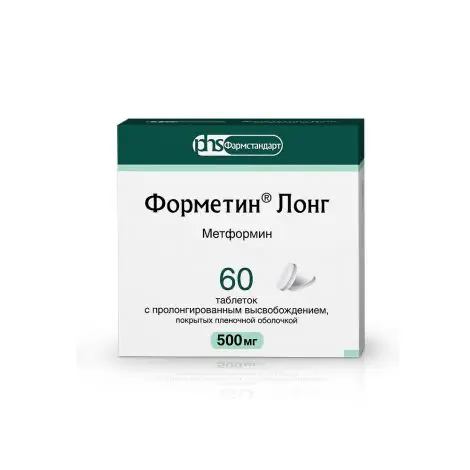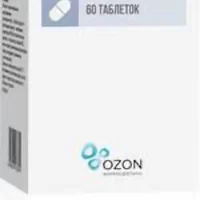Description
Glidica M Pharmacodynamics
Glidica® M is a combined hypoglycemic drug consisting of glimepiride and metformin.
Glimepiride pharmacodynamics
Glimepiride, one of the active substances of Glidica® M, is an oral hypoglycemic agent, a III generation sulfonylurea derivative.
Glimepiride stimulates insulin secretion and release from pancreatic beta-cells (pancreatic action), improves peripheral tissue (muscle and fat) sensitivity to the action of endogenous insulin (extrapancreatic action).
Effect on insulin secretion
Sulfonylurea derivatives increase insulin secretion by closing ATP-dependent potassium channels located in the cytoplasmic membrane of pancreatic beta cells.
By closing potassium channels, they cause depolarization of beta cells, which promotes the opening of calcium channels and increases calcium entry into the cells. Glimepiride binds to and detaches from the pancreatic beta-cell protein (mol mass 65 kD/SURX), which associates with ATP-dependent potassium channels at a high substitutive rate, but differs from the binding site of conventional sulfonylurea derivatives (protein with a mol mass 140 kD/SURl). This process leads to the release of insulin by exocytosis, and the amount of insulin secreted is significantly lower than with second-generation sulfonylurea derivatives (e.g., glibenclamide).
The minimal stimulating effect of glimepiride on insulin secretion also reduces the risk of hypoglycemia.
Extrapancreatic activity
Like conventional sulfonylurea derivatives, but to a much greater extent, glimepiride has pronounced extrapancreatic effects (reduction of insulin resistance, antiatherogenic, antiaggregant and antioxidant effects).
Glucose utilization by peripheral tissues (muscle and fat) occurs through special transport proteins (GLUT1 and GLUT4) located in cell membranes. Glucose transport to these tissues in type 2 diabetes is a rate-limited phase of glucose utilization. Glimepiride very rapidly increases the number and activity of glucose transporting molecules (GLUT1 and GLUT4), contributing to increased glucose uptake by peripheral tissues.
Glimepiride has a weaker inhibitory effect on ATP-dependent potassium channels of cardiomyocytes. Glimepiride administration preserves the ability of metabolic adaptation of myocardium to ischemia. Glimepiride increases phospholipase C activity, resulting in a decrease of intracellular calcium concentration in muscle and fat cells, causing a decrease of protein kinase A activity, which in turn leads to stimulation of glucose metabolism.
Glimepiride inhibits glucose output from the liver by increasing intracellular concentrations of fructose-2,6-bisphosphate, which in turn inhibits gluconeogenesis.
Glimepiride selectively inhibits cyclooxygenase and reduces the conversion of arachidonic acid to thromboxane A2, an important endogenous platelet aggregation factor.
Glimepiride helps to reduce the concentration of lipids, significantly reduces lipid peroxidation, which is associated with its anti-atherogenic effect.
Glimepiride increases endogenous α-tocopherol, catalase activity, glutathione peroxidase and superoxide dismutase, which helps to reduce the severity of oxidative stress, which is always present in patients with type 2 diabetes.
Pharmacodynamics of metformin
Metformin is a hypoglycemic drug from the group of biguanides. Its hypoglycemic effect is possible only if insulin secretion is maintained (although reduced). Metformin has no effect on the beta cells of the pancreas and does not increase insulin secretion. Metformin in therapeutic doses does not cause hypoglycemia in humans. The mechanism of action of metformin is not yet fully understood. It is suggested that metformin may potentiate the effects of insulin or that it may increase the effects of insulin in peripheral receptor areas. Metformin increases tissue sensitivity to insulin by increasing the number of insulin receptors on the surface of cell membranes. In addition, metformin inhibits gluconeogenesis in the liver, reduces free fatty acid formation and fat oxidation, reduces blood concentrations of triglycerides (TG), low density lipoproteins (LDL) and very low density lipoproteins (VLDL). Metformin slightly reduces appetite and reduces glucose absorption in the intestine. It improves blood fibrinolytic properties by inhibiting tissue plasminogen activator inhibitor.
Indications
Treatment of type 2 diabetes mellitus (in addition to diet, exercise, and weight loss):
– When glycemic control cannot be achieved with glimepiride or metformin monotherapy;
– when combined therapy with glimepiride and metformin monotherapy is replaced by taking the combined drug Glidica® M.
Contraindications .
– Diabetes mellitus type 1;
– Diabetic ketoacidosis, including history, diabetic coma and precoma, metabolic acidosis;
– Hypersensitivity to sulfonylurea derivatives, sulfonamides or biguanides, as well as to any of the drug excipients;
– Severe hepatic impairment (no experience of use; such patients require insulin treatment to ensure adequate glycemic control);
– Patients on hemodialysis (no experience of use);
– Renal failure and renal dysfunction (plasma creatinine concentration: ≥1.5 mg/dL (135 µmol/L) in males and ≥1.2
≥1.2mg/dL (110 µmol/L) in women or decreased creatinine clearance (increased risk of lactoacidosis and other side effects of metformin);
– Acute conditions in which renal function may be impaired (dehydration, severe infections, shock, intravascular administration of iodine-containing contrast agents (see section “Cautions”);
– Acute and chronic diseases that may cause tissue hypoxia (cardiac or respiratory failure, acute and subacute myocardial infarction, shock);
– Propensity to develop lactoacidosis, history of lactoacidosis;
– Stressful situations (severe trauma, burns, surgery, severe infections with fever, septicemia);
– Exhaustion, starvation, compliance with a hypocaloric diet (less than 1000 kcal/day);
– Disorder of absorption of food and drugs in the gastrointestinal tract (with intestinal obstruction, intestinal paresis, diarrhea, vomiting);
– Chronic alcoholism, acute alcohol intoxication;
– Lactase deficiency, galactose intolerance, glucose-galactose malabsorption;
– Pregnancy, pregnancy planning;
– The period of breastfeeding;
– Children and adolescents under 18 years of age (insufficient experience in clinical use).
Dosage and administration
- As a rule, the dose of Glidica® M should be determined by the patient’s target blood glucose concentration. The lowest dose sufficient to achieve the required metabolic control should be used. During treatment with Glidica® M, blood glucose concentration should be determined regularly. In addition, regular monitoring of glycated hemoglobin percentage in blood is recommended. Misadministration of the drug, e.g. skipping a dose, should never be compensated by taking a higher dose at a later time.
- The patient’s actions when taking the drug in error (in particular when missing the next dose of Glidica® M or when missing a meal) or in situations where it is not possible to take the drug should be discussed between the patient and the physician in advance.
Since improvement of metabolic control is associated with increased tissue sensitivity to insulin, during treatment with Glidica® M the need for glimepiride may decrease. In order to avoid the development of hypoglycemia, it is necessary to reduce the dose or discontinue Glidica® M in a timely manner. - Glidica® M should be taken once or twice a day with meals.
- Maximum single dose of metformin is 1000 mg.
- Maximum daily dose: for glimepiride is 8 mg, for metformin – 2000 mg.
- Only in a small number of patients a daily dose of glimepiride more than 6 mg is most effective.
- In order to avoid the development of hypoglycemia, the initial dose of Glimepiride® M should not exceed the daily doses of glimepiride and metformin already taken by the patient. When transferring patients from taking a combination of glimepiride and metformin monotherapy to Glidica® M, the dose of Glidica® M is determined based on the doses of glimepiride and metformin already taken as separate drugs. If it is necessary to increase the dose, the daily dose of Glidica® M should be titrated in increments of only 1 tablet of Glidica® M at a dose of 1 mg + 250 mg or ½ tablet of Glidica® M at a dose of 2 mg + 500 mg.
- Duration of treatment
Usually treatment with Glidica® M is prolonged. - Administration in children and adolescents under 18 years of age
Studies of safety and efficacy in children and adolescents under 18 years old with type 2 diabetes mellitus have not been conducted. - Administration in elderly patients
Metformin is excreted mainly by the kidneys. Since the risk of serious adverse reactions to metformin in patients with impaired renal function is higher, it should only be used in patients with normal renal function. Due to the fact that renal function decreases with age, metformin should be used with caution in elderly patients. - The dose should be carefully selected and renal function should be closely and regularly monitored.





